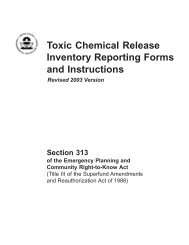(Lockout/Tagout) (revised 2002) OSHA 3120 - Seton
(Lockout/Tagout) (revised 2002) OSHA 3120 - Seton
(Lockout/Tagout) (revised 2002) OSHA 3120 - Seton
You also want an ePaper? Increase the reach of your titles
YUMPU automatically turns print PDFs into web optimized ePapers that Google loves.
What are the limitations of tagout devices?<br />
A tagout device is a prominent warning that clearly states<br />
that the machinery being controlled must not be operated until<br />
the tag is removed in accordance with an established procedure.<br />
Tags are essentially warning devices and do not provide the<br />
physical restraint of a lock. Tags may evoke a false sense of<br />
security. For these reasons, <strong>OSHA</strong> considers lockout devices<br />
to be more secure and more effective than tagout devices in<br />
protecting employees from hazardous energy.<br />
What are the requirements for lockout/tagout devices?<br />
Whether lockout or tagout devices are used, they must<br />
be the only devices the employer uses in conjunction with<br />
energy-isolating devices to control hazardous energy.<br />
The employer must provide these devices and they must<br />
be singularly identified and not used for other purposes.<br />
In addition, they must have the following characteristics:<br />
• Durable enough to withstand workplace conditions.<br />
<strong>Tagout</strong> devices must not deteriorate or become illegible<br />
even when used with corrosive components such as acid<br />
or alkali chemicals or in wet environments.<br />
• Standardized according to color, shape, or size. <strong>Tagout</strong><br />
devices also must be standardized according to print and<br />
format. Tags must be legible and understandable by all<br />
employees. They must warn employees about the hazards<br />
if the machine is energized, and offer employees clear<br />
instruction such as: “Do Not Start,” “Do Not Open,”<br />
“Do Not Close,” “Do Not Energize,” or “Do Not Operate.”<br />
• Substantial enough to minimize the likelihood of<br />
premature or accidental removal. Employees should be<br />
able to remove locks only by using excessive force with<br />
special tools such as bolt cutters or other metal-cutting<br />
tools. Tag attachments must be non-reusable, self-locking,<br />
and non-releasable, with a minimum unlocking strength<br />
12<br />
Control of Hazardous Energy (<strong>Lockout</strong>/<strong>Tagout</strong>)
















